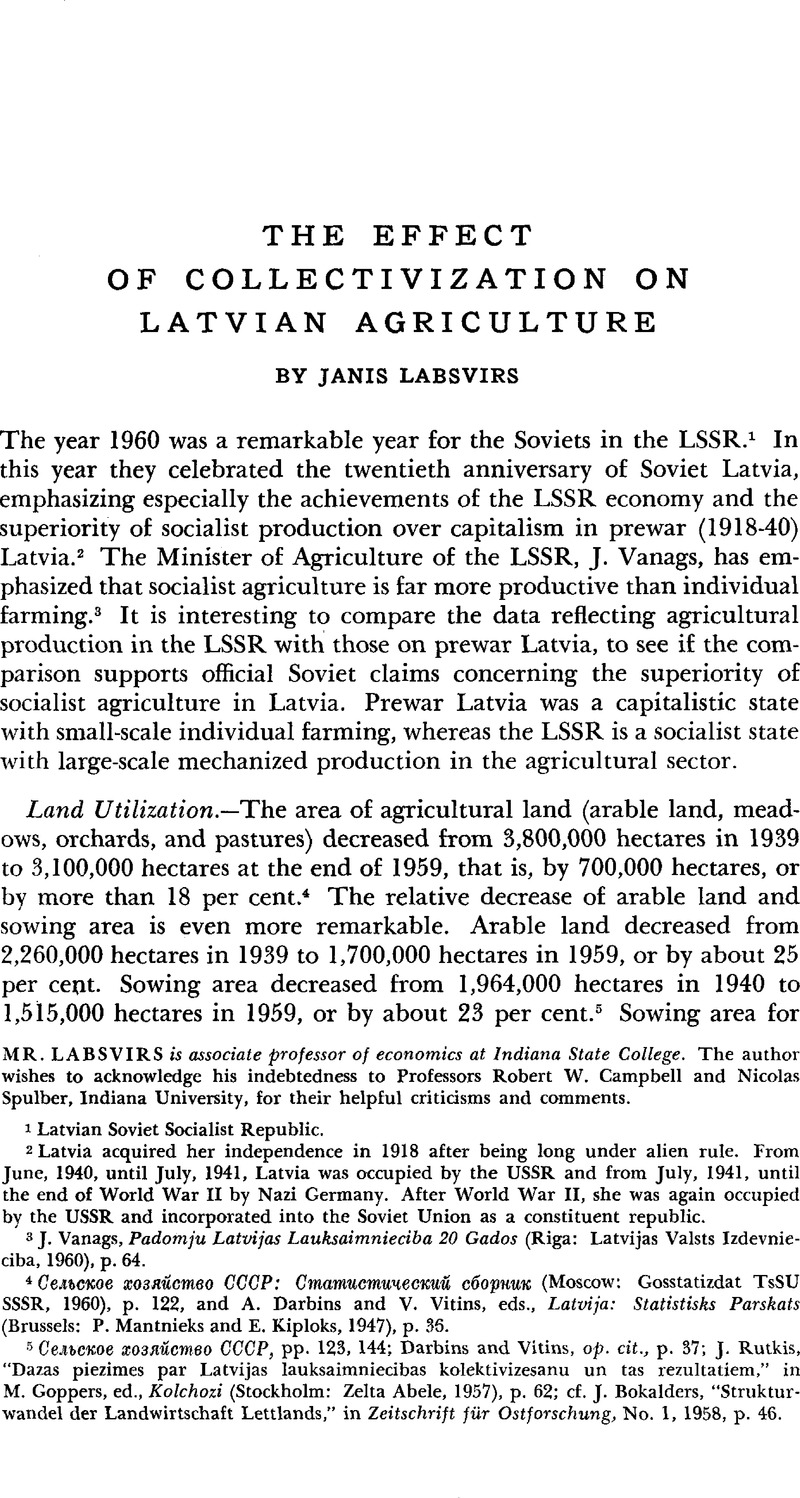No CrossRef data available.
Article contents
The Effect of Collectivization on Latvian Agriculture
Published online by Cambridge University Press: 27 January 2017
Abstract

- Type
- Notes and Comments
- Information
- Copyright
- Copyright © Association for Slavic, East European, and Eurasian Studies. 1963
References
1 Latvian Soviet Socialist Republic.
2 Latvia acquired her independence in 1918 after being long under alien rule. From June, 1940, until July, 1941, Latvia was occupied by the USSR and from July, 1941, until the end of World War II by Nazi Germany. After World War II, she was again occupied by the USSR and incorporated into the Soviet Union as a constituent republic.
3 Vanags, J., Padomju Latvijas Lauksaimnieciba 20 Gados (Riga: Latvijas Valsts Izdevnieciba, 1960, p. 64.Google Scholar
4
![]() (Moscow: Gosstatizdat TsSU SSSR, 1960), p. 122, and
Darbins, A. and Vitins, V., eds., Latvija: Statistisks Parskats (Brussels: P. Mantnieks and E. Kiploks, 1947), p. 36.Google Scholar
(Moscow: Gosstatizdat TsSU SSSR, 1960), p. 122, and
Darbins, A. and Vitins, V., eds., Latvija: Statistisks Parskats (Brussels: P. Mantnieks and E. Kiploks, 1947), p. 36.Google Scholar
5
![]() , pp. 123, 144; Darbins and Vitins, op. cit., p. 37;
Rutkis, J, “Dazas piezimes par Latvijas lauksaimniecibas kolektivizesanu un tas rezultatiem,” in Coppers, M., ed., Kolchozi (Stockholm: Zelta Abele, 1957, p. 62
Google Scholar; cf.
Bokalders, J., “Strukturwandel der Landwirtschaft Lettlands,” in Zeitschrift für Ostforschung, No. 1, 1958, p. 46.Google Scholar
, pp. 123, 144; Darbins and Vitins, op. cit., p. 37;
Rutkis, J, “Dazas piezimes par Latvijas lauksaimniecibas kolektivizesanu un tas rezultatiem,” in Coppers, M., ed., Kolchozi (Stockholm: Zelta Abele, 1957, p. 62
Google Scholar; cf.
Bokalders, J., “Strukturwandel der Landwirtschaft Lettlands,” in Zeitschrift für Ostforschung, No. 1, 1958, p. 46.Google Scholar
6
![]() , pp. 147, 150. Darbins and Vitins, op. cit., p. 37. It should be noted that the LSSR occupies an area of 64, 000 square kilometers as compared to prewar Latvia's 65, 800, that is, a decrease of about 2.7 per cent. See Padomju Latvijas Tautas Saimniecibas 20 Gadi: Statistisho Datu Krajums (Riga: Valsts Statistikas Izdevniecibas Latvijas Nodala, 1960), p. 20. The following table shows the distribution of sowing area among different sectors of production in 1959.
, pp. 147, 150. Darbins and Vitins, op. cit., p. 37. It should be noted that the LSSR occupies an area of 64, 000 square kilometers as compared to prewar Latvia's 65, 800, that is, a decrease of about 2.7 per cent. See Padomju Latvijas Tautas Saimniecibas 20 Gadi: Statistisho Datu Krajums (Riga: Valsts Statistikas Izdevniecibas Latvijas Nodala, 1960), p. 20. The following table shows the distribution of sowing area among different sectors of production in 1959.
7 Podcasova, A., Socialistiska atrazosana padomju Latvijas kolchozos (Riga: Latvijas Valsts Izdevnieciba, 1958, p. 286.Google Scholar
8
![]() , p. 211; Latvju Enciklopedija, Arveds Svabe, ed. (3 vols.; Stockholm: Tris Zvaigznes, 1950-55), II, 1370.
, p. 211; Latvju Enciklopedija, Arveds Svabe, ed. (3 vols.; Stockholm: Tris Zvaigznes, 1950-55), II, 1370.
9 The loss in grain yield (in 1950-55) owing to late harvesting and threshing is estimated by Latvian Soviet economists to be 40 per cent of the total on-the-root yield. See Podcasova, op. cit., pp. 125-27.
10 N. Jasny assumes that the average grain yields in the Baltic countries “are now [1956- 1957] 5 to 6 quintals per hectare; it may be necessary to go back a century or two to find such a yield in the Baltic States in the past.” See Jasny, Naum, The Soviet 1956 Statistical Handbook: A Commentary (East Lansing: Michigan State University Press, 1957), pp. 98, 99.Google Scholar
11 N. Jasny, by using data provided by the International Institute of Agriculture (International Yearbook of Agricultural Statistics, 1946, pp. 10-31), gives the average grain yields in Latvia in 1935-39 as 11.1 quintals per hectare. Jasny, op. cit., p. 98. Even then the decrease in grain yields amounts to about 48 per cent.
12 The number of milk cows decreased from 890, 000 in 1939 to 543, 000 in 1960 or by about 39 per cent. ![]() , p. 277; Darbins and Vitins, op. cit., p. 44. The following table shows the number of livestock in socialized and individual sectors at the end of 1959.
, p. 277; Darbins and Vitins, op. cit., p. 44. The following table shows the number of livestock in socialized and individual sectors at the end of 1959.
13 It is interesting to note that the number of cattle and sheep even in 1913 exceeded that in 1960. In 1913 there were 912, 000 cattle and 996, 000 sheep. Latvju Encikhpedija, II, 1372.
14
![]() , pp. 339, 350, 360; Latvju Enciklopedija, II, 1372-73; Rutkis in Goppers, ed., Kolchozi, p. 64.
, pp. 339, 350, 360; Latvju Enciklopedija, II, 1372-73; Rutkis in Goppers, ed., Kolchozi, p. 64.
15 For implications in Soviet statistics regarding the data for milk production see D. Gale Johnson and Arcadius Kahan, “Soviet Agriculture: Structure and Growth,” in Joint Economic Committee, U.S. Congress, 86th Congress, 1st session, Comparisons of the United States and Soviet Economies, Part I (Washington, D.C.: Government Printing Office, 1960), pp. 201-3.
16
![]() , p. 318.
, p. 318.
17 in 1951-55, the average milk yield in many districts amounted to only 1, 000 to 1, 500 kg. per cow. Cf. Podcasova, op. cit., p. 156.




